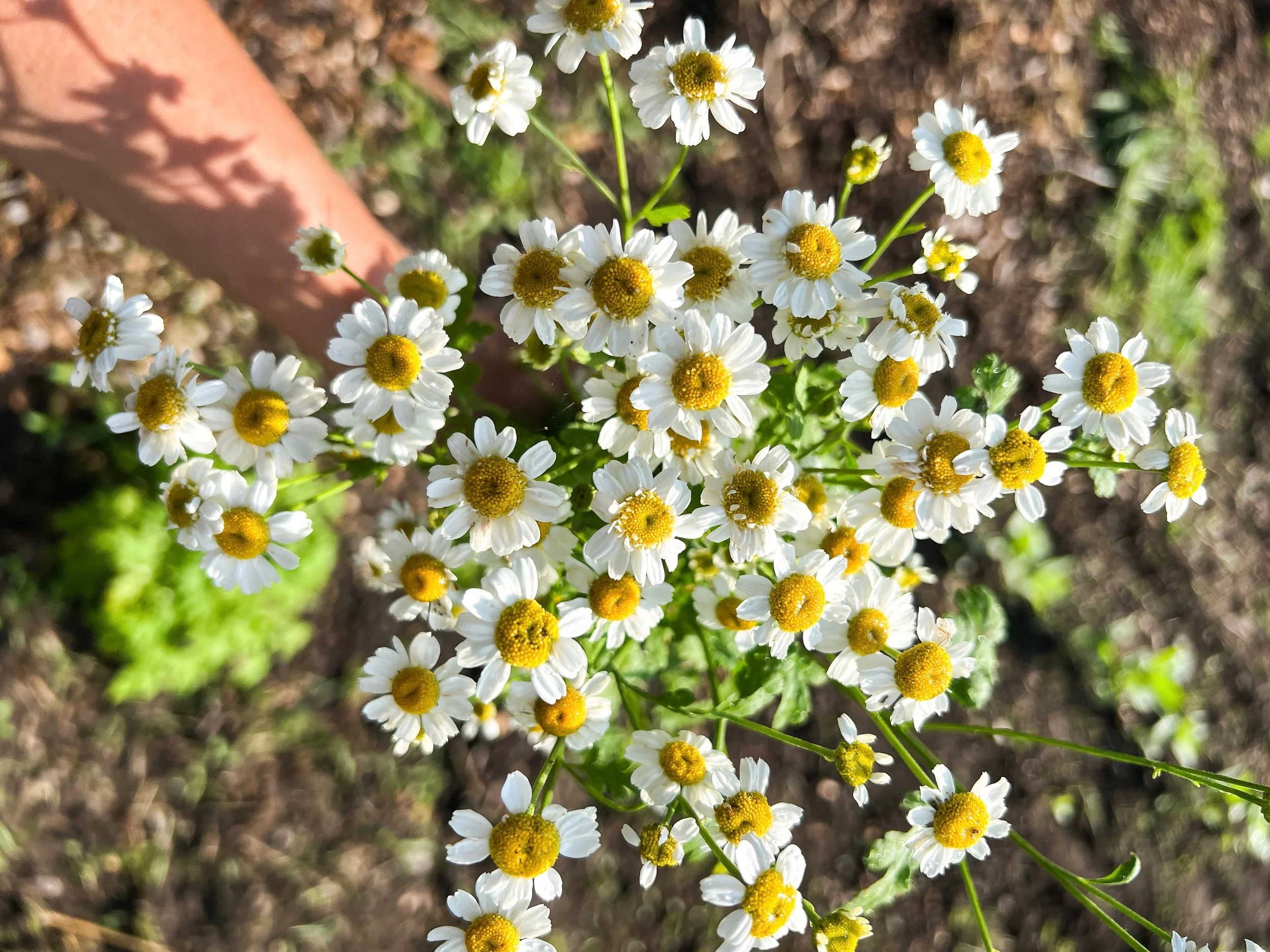Feverfew: The Tiny Flower That Changed Everything
Personal reflections, historical roots, and how this ancient herb helps modern migraine sufferers find relief
I grew up with occipital migraines — the kind that start as a tension at the base of the skull and grow into full-blown pain that pulses behind your eyes and makes the world go fuzzy. For years, I just endured them. I didn’t know there were herbs that could help, especially not in a meaningful, long-term way.
That changed when I discovered feverfew.
Small and unassuming, feverfew grows like a wild daisy. But its healing roots go back thousands of years — and when I first learned its story, I knew: I have to grow this. Not just for beauty, not just for knowledge — but because something deep in me believed this plant was part of my healing.
And now? I’ve finally harvested my first flowers and leaves to tincture. A tiny batch, but a powerful one.
What is Feverfew?
Botanical name: Tanacetum parthenium
Common names: Featherfew, Featherfoil, Medieval aspirin
Family: Asteraceae (daisy family)
Feverfew is a hardy perennial herb with delicate, fern-like leaves and small white flowers with bright yellow centers. Native to the Balkans and Eastern Europe, it has naturalized widely — especially in cottage gardens where its lacy foliage and cheerful blooms bring a wild elegance.
But this isn’t just a pretty plant. It’s one of the most well-documented herbs for migraine prevention.
A Brief History
Feverfew has been used medicinally since at least the 1st century, with Greek physician Dioscorides recommending it to treat inflammation and “hot fevers” — hence the name feverfew.
In medieval Europe, it was commonly called medieval aspirin. Women planted it near homes to ease everything from fevers to headaches to emotional unrest. It was also thought to protect against evil spirits — an herb of both body and soul.
In more recent decades, feverfew gained attention in clinical research for its effects on chronic migraines, arthritis, and inflammatory disorders. Studies confirm that its active constituent, parthenolide, helps inhibit prostaglandins and serotonin release — key players in migraine onset.
Herbal Actions
Anti-inflammatory
Vasodilatory (opens blood vessels)
Antispasmodic
Bitter digestive stimulant
Mild relaxant
How It’s Used
Migraine Prevention
The most famous use. Feverfew is taken daily (often as a tincture or capsule) to reduce the frequency and intensity of migraines. It doesn’t stop a migraine in progress, but it may significantly reduce how often they occur over time.
Joint Pain & Arthritis
Due to its anti-inflammatory properties, feverfew can also help manage chronic pain, especially when it’s linked to systemic inflammation.
Digestive Bitters
Its bitter flavor makes it a good addition to formulas that stimulate digestion and support the liver. In small amounts, it encourages bile flow and digestive ease.
Hormonal Support
While not its primary use, some herbalists incorporate feverfew into formulas to support hormonal balance, especially when migraines are linked to menstrual cycles.
Important Notes
Not for use during pregnancy or breastfeeding.
Can cause mouth ulcers or irritation if taken fresh in large quantities.
Avoid if allergic to ragweed or other daisies.
Use caution when combining with blood thinners or other anti-inflammatory medications.
Making My First Feverfew Tincture
This week, I harvested a small amount of fresh feverfew from my garden — just enough to fill a mason jar. I chopped the leaves and flowers, covered them with vodka, and labeled the jar to steep for 4–6 weeks.
Because parthenolide degrades quickly, fresh herb is preferred for tincture-making. Drying is possible, but some potency may be lost.
It’s a humble batch. But it holds so much meaning.
Final Thoughts
Feverfew isn’t a trendy wellness herb. It’s not glamorous or widely known. But for centuries, women and healers have turned to it for help with the quiet battles — pain, tension, unrest. I think that’s what makes it so special. It’s not a flash-in-the-pan cure. It’s a steady, grounded companion for the long road.
If you’ve lived with migraines — or just sensed a pull toward this plant like I did — I hope this post helps you feel seen and empowered.
And if you’re interested, I’d love to share more as I test this tincture and bring feverfew into my herbal offerings. There’s something sacred about walking with a plant for the first time — and even more sacred in teaching others how to do the same.
If you’d like to check out our current teas and herbal offerings, check out our shop here.

